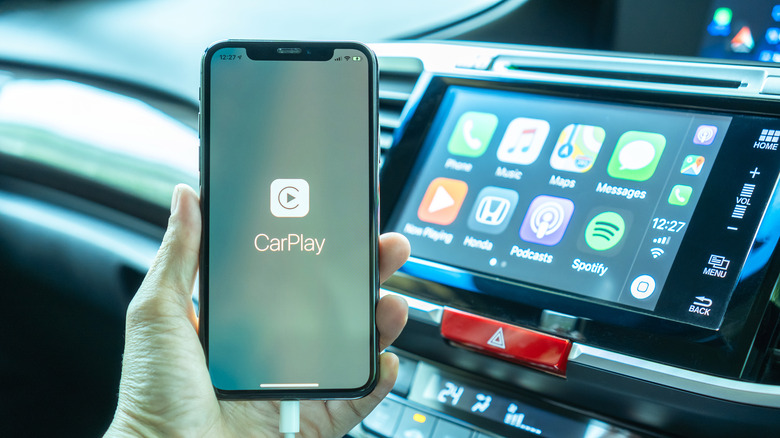
Updated 12/13/2023: After this article was published, a GM representative reached out to SlashGear claiming that the company’s position on the phone’s offering had been “misrepresented” by MotorTrend. The company said: “We wanted to communicate to clarify that comments about GM’s position on the phone display were misrepresented and to reinforce our valuable partnerships with Apple and Google and each company’s commitment to driver safety.” “GM’s integrated infotainment strategy is driven by the benefits of having a system that allows for greater integration with the larger GM ecosystem and vehicles.”
Earlier this year, General Motors announced the controversial decision to eliminate Apple CarPlay and Google’s Android Auto from its upcoming fleet of electric vehicles. The decision was not liked by many people and even Volvo’s CEO, Jim Ruane, criticized GM, stating that this was not the right approach. “You have to know where you’re spending your engineering dollars and what the benefit is to the customer or shareholders.”
GM President Tim Babbitt has now offered an explanation behind the controversial move, telling Motor Trend that it has more to do with the safety and reliability of Apple and Google’s in-car solutions than an attempt to lock users into its digital infotainment system. “According to Babbitt, both CarPlay and Android Auto suffer from stability issues that manifest as poor connections, poor display, slow responses, and dropped connections,” the report says.
Babbitt went on to explain that when CarPlay and Android Auto aren’t working as intended, the driver naturally turns their attention back to their smartphone, which is unsafe. There is certainly automotive research literature that supports Babbitt’s concerns. According to a research paper published in the Journal of Radiation Research and Applied Science, the majority of drivers turn their attention to smartphones while driving in order to answer calls, send messages, or even browse social media – all three of which have become the primary tool of modern smartphones, but which constitute At the same time there are safety risks when the driver cannot act in time.
GM hopes it will be more reliable
While emphasizing the reliability aspect of CarPlay and Android Auto, Babbitt points out that fixing these software malfunctions is outside the automaker’s control. Additionally, when these reliability issues arise, they defeat the entire purpose of their existence in the first place, as the driver eventually turns their attention to the smartphone. GM is essentially banking on the idea of removing smartphones from the equation while at the same time hoping its ‘Ultifi’ in-car infotainment system doesn’t come with any reliability issues.
Regarding the GM CEO’s concerns about reliability risks, other research published in the journal Psychological Risk Factors for Road Safety confirmed “vulnerability associated with cell phone use among young drivers leading to poor vehicle control.” But no matter what outside research says, resorting to its own solution is a big bet, especially given the fact that GM itself hasn’t tested the theory in lab or real-world scenarios, and is simply making good on its promise of “high potential.” This can backfire spectacularly. Plus, there’s a reason why every other automaker is putting their faith in Apple and Google, while GM is choosing the hard route of slow, expensive R&D to create its own infotainment suite that’s supposed to solve phone-fueled driver distraction problems.
Hidden motives with Ultifi
Babbitt also highlights the crucial issue of phone compatibility, especially with Android phones that want to integrate seamlessly with a car’s infotainment system. The GM executive also stressed that the culprits of common complaints are Android Auto and CarPlay, but owners often blame the automaker for these issues. Once again, scientific research confirms Babbitt’s concerns. A study in the National Library of Medicine Repository analyzed driver data and found “a strong relationship between distracted processes and driving control behavior.”
GM hopes the native digital infotainment system will reduce poor consumer perception of its cars on the road. But GM’s careful attempt to secure the ecosystem is hard to ignore. Yes, it can solve the lack of features by bringing essential services like Google Maps and music streaming to its Ultifi software. However, by doing this, the GM may also offload a few of the processes you may be performing on the phone. If the current trend of locking car features behind a subscription is anything to go by, GM’s plans don’t instill much confidence.
Unfortunately, such a future appears to be on GM’s road map. “In addition to being able to buy things from GM or GM partners through their car’s infotainment system, GM is also looking at subscription services that can be managed through the same interface,” the Motor Trend report says. On the plus side, GM’s original infotainment system will provide access to more driver data that can speed up fault resolution and improve the entire system.
General Motors (GM) has made the bold decision to completely move away from Apple CarPlay and Android Auto in their future vehicles. This move has sparked a lot of interest and speculation as to why they would make such a drastic change. With the growing popularity of these smartphone integration systems, it seems counterintuitive for GM to abandon them. However, the company has their reasons for doing so, and it will be interesting to see how this decision plays out in the future of car technology.


